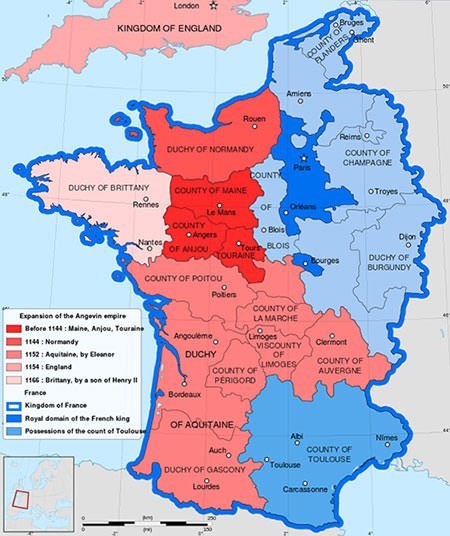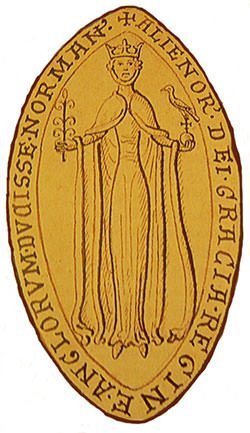Eleanor of Aquitaine was one of the wealthiest and most powerful women in Europe during twelfth century AD who served as both Queen of France and Queen of England through her two marriages. Eleanor was the daughter of the duke of Aquitaine, the largest and richest province of France. She was married to Louis VII of France shortly after the death of her father in April 1137. She famously accompanied her husband Louis in the Second Crusade. Her first marriage was annulled in March 1152 and shortly after that she married the future king of England, Henry II. Eleanor maintained control of her lands as Aquitaine defied the authority of Henry and during the reign of her son Richard, she even acted as regent of England. Eleanor of Aquitaine was one of the most influential women of her time. Here are 10 interesting facts about her childhood, family, life, marriages, accomplishments and death.
#1 SHE BECAME HEIR TO THE LARGEST AND RICHEST PROVINCE OF FRANCE
Eleanor was born in what is now south-western France, likely in Poitiers, Bordeaux or Nieul-sur-l’Autise. Her year of birth is also not known with certainty. It was either 1122 or 1124. Eleanor was the eldest child of William X, Duke of Aquitaine, and his wife Aenor de Châtellerault, daughter of the Viscount of Châtellerault. William X and Aenor had another daughter named Petronilla around 1125; and a son named William Aigret. Eleanor’s mother Aenor and her brother William Aigret died in the year 1130. This left Petronilla as Eleanor’s only surviving legitimate sibling. Eleanor thus became entitled to inherit her father’s domains. The Duchy of Aquitaine was the largest and richest province of France and this made Eleanor the most sought after match in Europe.

#2 SHE WAS MARRIED TO LOUIS VII OF FRANCE SHORTLY AFTER THE DEATH OF HER FATHER
Eleanor received the best possible education learning arithmetic and history; household skills; dancing and games; as well as hunting and horse riding. Her father William X was aware that Eleanor was a highly sought after single woman and, at the time, kidnapping an heiress was seen as a viable option of obtaining a title. William X died on 9th April 1137 but before that he placed his eldest daughter under the guardianship of King Louis VI of France. Louis VI, known as Louis the Fat, was suffering from a bout of dysentery at the time and was gravely ill. Despite his illness, he ensured that his son and heir Prince Louis was quickly married to Eleanor. Prince Louis married Eleanor of Aquitaine on 25th July 1137 at the Cathedral of Saint-André in Bordeaux, France. Louis was 17 while Eleanor was around 15 at the time of their marriage.

#3 ELEANOR BECAME THE QUEEN OF FRANCE IN HER TEENAGE
Immediately after the wedding, Prince Louis and Eleanor were enthroned as Duke and Duchess of Aquitaine. As a wedding present, Eleanor gave Louis a vase made of rock crystal, a type of hardstone carving. This rock crystal vase is is the only artefact of Eleanor’s known to exist today and is currently held at the Louvre Museum in Paris, France. On August 1, 1137, Louis VI died of dysentery. On December 25 of the same year, Prince Louis was crowned King Louis VII of France and Eleanor of Aquitaine became the Queen of France in her teenage. Louis VII was madly in love with his beautiful, capricious and worldly wise bride in the initial years of their marriage and Eleanor of Aquitaine held considerable influence over him. She soon secured her position as an important partner of her husband in governing France.

#4 ELEANOR ACCOMPANIED HER HUSBAND IN THE SECOND CRUSADE AGAINST MUSLIMS
In 1145, Pope Eugene III requested Louis VII to lead a crusade to the Middle East to rescue the Frankish Kingdoms there. Eleanor of Aquitaine had been corresponding with her uncle Raymond, Prince of Antioch, one of the crusader states created during the First Crusade. Eleanor decided to participate in the crusade. She recruited some of her royal ladies-in-waiting, as well as 300 non-noble Aquitainian vassals, for the campaign. This Second Crusade, launched from Europe as holy war against Islam, proved to be a disaster for Louis and a great victory for the Muslims. During the crusade, there were also rumours of an affair between Eleanor and her uncle Raymond. Reportedly, Eleanor also requested to stay with her uncle but Louis took her from Antioch against her will and continued on the campaign.

#5 HER MARRIAGE WITH LOUIS VII WAS ANNULLED AFTER 15 YEARS
Although Eleanor was married to the king of France, according to law Aquitaine would remain independent of France until her oldest son became both King of the Franks and Duke of Aquitaine. The marriage of Eleanor and Louis, which was already experiencing difficulties as their first child had been a girl, became further estranged after rumours of Eleanor’s affair with her uncle. Eleanor wanted the marriage to be annulled on the grounds of consanguinity, that she and her husband were too closely related. Pope Eugene, however, refused to grant annulment and attempted to reconcile the couple. Eleanor and Louis had another child in 1150, a girl named Alix. A couple of years later, on 11th March 1152, their marriage was annulled on grounds of consanguinity. Their two daughters, however, were declared legitimate and custody was given to King Louis VII.

#6 SHE BECAME THE QUEEN OF ENGLAND THROUGH HER SECOND MARRIAGE
When Eleanor was travelling to Poitiers after her annulment, two lords tried to kidnap her to claim her lands. On reaching her destination, Eleanor immediately sent envoys to Henry, Duke of Normandy and future king of England, to marry her as soon as possible. Eleanor of Aquitaine married the future King Henry II of England in a cathedral in Poitiers on 18th May 1152, eight weeks after her annulment. Eleanor was related to Henry even more closely than she had been to Louis, they were cousins to the third degree while she and Louis were cousins to the fourth degree. Henry became King of England on 25 October 1154 and on December 19, Eleanor of Aquitaine was crowned Queen of England. Over the next 15 years, the couple had eight children: five sons named William, Henry, Richard, Geoffrey and John; and three daughter named Matilda, Eleanor and Joan.
#7 HER SUPPOSED COURT OF LOVE CONTRIBUTED TO FLOWERING OF LITERATURE
During her second marriage, Eleanor maintained control of her lands as Aquitaine defied the authority of Henry and answered only to their Duchess. Also, Henry was frequently absent from England and Eleanor maintained control of the country while he was away. Many writs were probably issued in her name, of which nine survive till today. In 1168, Eleanor moved to Poitiers and she remained there till 1173. During this time, she is said to have established her famed Court of Love. Eleanor’s court at Poitiers largely focused on courtly love and symbolic ritual; and was reported to have attracted artists and poets, and to have contributed to a flowering of culture and the arts. Its ideas were eagerly taken up by the writers of the day and were promoted through poetry and literature. Though the existence of Eleanor’s Court of Love is debated, its legend most likely contributed to increased popularity of courtly love literature in western Europe.

#8 ELEANOR REMAINED IN PRISON FOR 16 YEARS FOR REVOLTING AGAINST HENRY II
In 1173, three sons of King Henry II revolted against their father in what is known as the Revolt of 1173–74. It was led by his second son with Eleanor, known as Henry the Young. He was their eldest surviving son as their first child William died in infancy. Henry the Young wanted more power than granted to him by his father. Eleanor sided with her sons during the revolt, which ended in failure after eighteen months. Eleanor was arrested and imprisoned by Henry II during the revolt. She was to remain a prisoner for 16 years from 1173 to 1189. Eleanor was not allowed to see her sons very often during her imprisonment, though she was released for special occasions such as Christmas. Henry the Young died in 1183 during a campaign against his father, after contracting dysentery. King Henry II died on 6th July 1189. He was succeeded by his third son with Eleanor, Richard I of England. One of the first acts of Richard I as king was to set his mother free.
#9 SHE ACTED AS REGENT DURING THE ABSENCE OF HER SON KING RICHARD
Soon after he ascended the throne, Richard I was engaged in a crusade from 1190 to 1192. He was then held in captivity by Henry VI, the Holy Roman Emperor. Eleanor of Aquitaine ruled as a regent in the absence of her son Richard. She reigned in her son’s name with nearly complete control of England even issuing commands in her name. Eleanor raised the money demanded by Henry VI as ransom for Richard and negotiated with the Holy Roman Emperor to secure the release of her son. After being released in 1194, Richard ruled England till his death on 6th April 1199. Richard had named his nephew, Arthur of Brittany, as his heir. Eleanor once again took control and ensured that it was her son John who ruled after his brother. She acted as an envoy to France for her youngest son John.

#10 ELEANOR OF AQUITAINE WAS ONE OF THE MOST INFLUENTIAL WOMEN AT HER TIME
Eleanor of Aquitaine died on April 1, 1204, at a reported age of 82. She was buried in a tomb designed on her orders at Fontevraud Abbey, next to that of her husband Henry and her son Richard. Her tomb effigy shows her reading a bible and is decorated with magnificent jewellery. Eleanor of Aquitaine was one of the wealthiest and most powerful figures in Europe during the Middle Ages and perhaps the most influential woman in Europe during her time. She went on a Crusade, as few queens could; married the second time by her choice; ruled as regent for her son; and maintained control over most of her life at a time when women yielded power to their husbands. She has been depicted in numerous books, plays, television series and films; and remains a feminist icon.

THE TWO POPULAR SONS OF ELEANOR OF AQUITAINE
The third son of Eleanor with Henry, Richard I, came to be known as Richard the Lionheart because of his reputation as a great military leader and warrior. He led England against the Muslim sultan Saladin in the Third Crusade. The campaign is considered mostly successful for Europe. Richard the Lionheart remains an iconic figure both in England and in France. The youngest son of Eleanor with Henry, John, succeeded his brother in 1199. He is considered an able administrator and general but is thought to be spiteful and cruel. John remains a popular character as he is depicted as the villain in the tales of the legendary hero Robin Hood.


this is a really good website
Thanks for your appreciation.
lol
lol